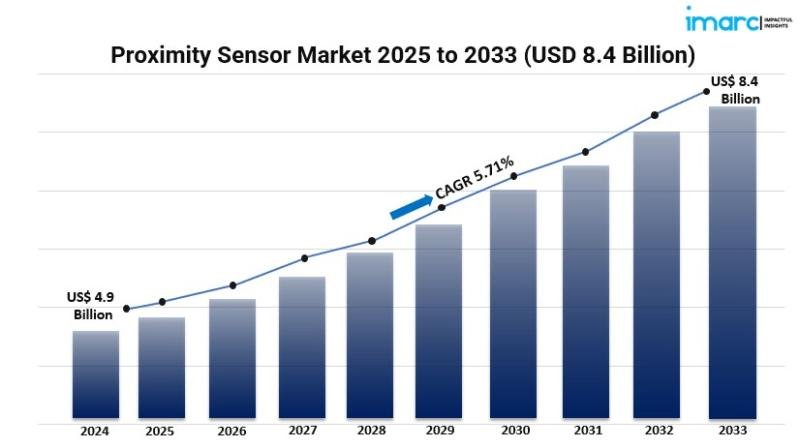MARKET OVERVIEW:
The global proximity sensor market is experiencing rapid growth, driven by advancements in automation across industries, increased consumer electronics demand, and automotive safety innovations. Proximity sensors, integral in manufacturing, aerospace, and IoT applications, are projected to grow from USD 4.9 billion in 2024 to USD 8.4 billion by 2033, expanding at a compound annual growth rate (CAGR) of 5.71%. This market expansion reflects the growing need for smart systems and enhanced operational efficiency.
STUDY ASSUMPTION YEARS:
• BASE YEAR: 2024
• HISTORICAL YEAR: 2019-2024
• FORECAST YEAR: 2025-2033
PROXIMITY SENSOR MARKET KEY TAKEAWAYS:
• The market size in 2024 is USD 4.9 billion and is expected to reach USD 8.4 billion by 2033, growing at a CAGR of 5.71%.
• Major growth drivers include automation in manufacturing, automotive safety systems, and demand for IoT devices.
• Technological trends such as miniaturization and wireless communication are fostering market expansion.
• The Asia Pacific region is the market leader, with strong industrial and automotive manufacturing bases.
• Proximity sensors are crucial in enhancing the functionality of consumer electronics, especially smartphones and wearables.
• Rising automotive safety standards and innovations in autonomous vehicles are propelling market demand.
MARKET GROWTH FACTORS:
Technological Advancements:
Innovation, which includes miniaturization and enhanced sensing accuracy in proximity sensors, is crucial for market growth. With increasing demand for compact and efficient sensors, improvements in proximity sensing technology will make it possible to integrate proximity sensors into various lightweight devices such as smartphones, wearables, and autonomous systems. Besides this, they’ve enabled a flexible efficient deployment of sensors through an array of applications because of this new revolution in wireless communication channels. At the same time, automation and smart systems have compelled industries to continue developing more-powerful and accurate proximity sensors for widespread adoption.
Increased Adoption in Consumer Electronics:
A significant market driver for proximity sensors includes global consumer electronics. These devices include smartphones, tablets, laptops, and wearable equipment. For instance, features such as auto locking or dimming of screens under users’ proximity have been made possible because of these sensors. However, as more smartphone devices come up and more IoT devices proliferate, demand for such proximity sensors installation in these devices is expected to rise. With the continuous evolution of the consumer electronics industry, proximity sensors will remain at the center stage of improvement in device performance and user experience, thus creating further opportunities for market expansion.
Growth in the Automotive Sector:
Proximity sensors are gaining an increasing presence in the automotive industry. This is mainly because of the increasing number of safety regulations and rising investment in technology on autonomous driving. These sensors would enhance the functions of collision avoidance, parking assistance, and other active safety systems in a vehicle. Their functions in autonomous and semi-autonomous cars are yet increasing, given that they would help navigate systems with their environment. The fact that the market for automotive safety systems is going to grow significantly means that demand for proximity sensors in cars will also boost their overall market growth.
Request for a sample copy of this report: https://www.imarcgroup.com/proximity-sensor-market/requestsample
MARKET SEGMENTATION:
By Technology:
• Inductive Proximity Sensors: Used for detecting metallic objects through electromagnetic fields.
• Capacitive Proximity Sensors: Detect the presence of non-metallic objects by measuring changes in capacitance.
• Photoelectric Proximity Sensors: Use light to detect objects and are highly accurate over long distances.
• Magnetic Proximity Sensors: Respond to changes in magnetic fields for non-contact sensing.
• Others: Includes various other sensor types used in specific applications.
By Sensing Range:
• 0 MM-20 MM Sensing Range: Short-range sensors used in compact devices and applications.
• 20 MM-40 MM Sensing Range: Medium-range sensors suited for industrial and automotive uses.
• Greater Than 40 MM Sensing Range: Long-range sensors used in automotive safety systems and large machinery.
By End-Use Industry:
• Aerospace and Defense: Used in aircraft and defense systems for proximity detection and safety.
• Automotive: Employed in vehicles for parking assistance, collision avoidance, and autonomous systems.
• Industrial: Utilized in manufacturing automation to detect objects and improve production processes.
• Consumer Electronics: Found in smartphones, tablets, and wearables to enhance user experience.
• Food and Beverage: Used in food processing and packaging to ensure safety and efficiency.
• Others: Includes various niche applications across different industries.
• Breakup by Region:
o North America (United States, Canada)
o Asia Pacific (China, Japan, India, South Korea, Australia, Indonesia, Others)
o Europe (Germany, France, United Kingdom, Italy, Spain, Russia, Others)
o Latin America (Brazil, Mexico, Others)
o Middle East and Africa
REGIONAL INSIGHTS:
Asia Pacific leads the market for proximity sensors, considering its heavy industrial and automotive manufacturing base, mainly in China, Japan, and India. The above-mentioned reasons account for the importance relating to the use of automation in manufacturing and, hence, the growth of the demand for safety sensors in the automotive industry. Further, such factors as technological advancements and higher investment into smart infrastructure have continued to fuel demand for proximity sensors in the region.
RECENT DEVELOPMENTS & NEWS:
Such changes in the market bring to notice the increased use of proximity sensors within various industries, such as automation and automotive safety. For example, with proximity sensor integration in autonomous vehicles, new feats could be achieved by advanced driver-assistance systems (ADAS) towards vehicle safety. Similar to that, as more proximity sensors are being adopted into consumer electronics for use in smartphones and wearables as well as IoT devices, greater improvements in user experience in automation and energy saving will also be manifested.
KEY PLAYERS:
Autonics Corporation, Balluff GmbH, Datalogic S.p.A., Fargo Controls Inc., Honeywell International Inc., Keyence Corporation, OMRON Corporation, Panasonic Corporation, Pepperl+Fuchs SE, Riko Opto-Electronics Technology Co. Ltd, Rockwell Automation Inc., Sick AG, STMicroelectronics, etc.
If you require any specific information that is not covered currently within the scope of the report, we will provide the same as a part of the customization.
Ask Analyst for Customization: https://www.imarcgroup.com/request?type=report&id=5354&flag=C
About Us:
IMARC Group
134 N 4th St. Brooklyn, NY 11249, USA
Email: sales@imarcgroup.com
Tel No:(D) +91 120 433 0800
United States: +1-631-791-1145
IMARC Group is a global management consulting firm that helps the world’s most ambitious changemakers to create a lasting impact. The company provide a comprehensive suite of market entry and expansion services. IMARC offerings include thorough market assessment, feasibility studies, company incorporation assistance, factory setup support, regulatory approvals and licensing navigation, branding, marketing and sales strategies, competitive landscape and benchmarking analyses, pricing and cost research, and procurement research.
This release was published on openPR.


















